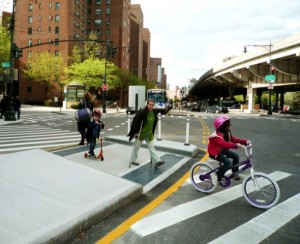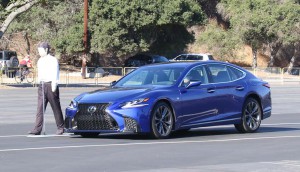Highway deaths have been on the rise in recent years, reversing a long period of improved roadway safety. And one reason for the deadly turnaround has been the skyrocketing increase in pedestrian fatalities.
Since 2009, the number of pedestrians killed in motor vehicle crashes has jumped by nearly 50%, and a number of factors are being blamed, including the use of mobile devices by both motorists and pedestrians. But a new study by the Insurance Institute for Highway Safety puts a chunk of the blame on the increasing number of SUVs on the road.
Both the number SUVs and their design appear to be factors, according to David Harkey, the president of the insurance industry trade groups, who noted that, “SUVs have higher front ends, and often the design for the vehicle is much more vertical than passenger cars.” That can make for a more blunt impact and less likelihood that a pedestrian being struck by an SUV might be able to roll off the vehicle and reduce injuries.
(Distracted driving problem? Nope. It’s an epidemic. Click Here for the story.)
In 2016, the most recent year included in the IIHS study, nearly 6,000 American pedestrians were killed in motor vehicle crashes. That was a 46% jump from 2009, according to data from the National Highway Traffic Safety Administration. The IIHS study indicated that during the same period, the number of pedestrians killed in accidents specifically involving SUVs jumped by 81%, based on the federal statistics.

A new IIHS study warns the blunt front ends of SUVs could be one factor in rising pedestrian fatalities.
The number may be inflated by the fact that there were tens of millions more SUVs on the road in 2016 than there were at the end of the prior decade, so deaths involving sedans and other types of vehicles went down, in some instances solely because there are fewer of them in use each year.
But experts stress that SUVs don’t shoulder the blame alone. They also point to a range of issues including poor street lighting, increased use of once-illegal and now often recreationally available marijuana.
A report released earlier this year by the Governors Highway Safety Association noted that in seven states and the District of Columbia where recreational use of marijuana has been legalized, there has been a sharp increase in pedestrian deaths, though the report stressed that there was not a clear and definitive link.
“We are not making a definitive, cause-and-effect link to marijuana,” the study’s author, Richard Retting, told the New York Times. “It may be a canary in a coal mine, an early indicator to address.”
The authors also pointed to a problem that is already high on the radar. In general, distracted driving has been blamed by NHTSA for roughly one in 10 of all highway deaths, and is linked to the rise in pedestrian fatalities, in particular, because both drivers and those on foot may lose sight of what’s happening when they’re lost in e-mail or texting.
“We’ve got distracted drivers and we’ve got distracted pedestrians, and that is a deadly combination,” Rebecca Lindland, a Kelley Blue Book auto analyst, noted in a statement, when 2017 pedestrian fatality statistics were released recently. They hovered near the 6,000 mark for the second year in a row.
(After sharp increase, overall traffic fatalities fell slightly in the first half of 2017, Click Here for the story.)
Not only are motorists often failing to keep their eyes on the road but so are pedestrians who often walk across intersections, their eyes glued to a smartphone screen, without looking for oncoming traffic. Others, wearing headphones, may not hear an approaching car, even when the driver blows their horn, experts note.
While the improper use of smartphones and other consumer electronic devices may be contributing to pedestrian and other fatal highway crashes, automakers are hoping to use other forms of technology to make roadways safer. A growing number of vehicles are being equipped with forward collision warning systems that can predict a potential crash and alert the driver to apply the brakes. More advanced versions also can hit the brakes automatically if the driver doesn’t immediately respond.
Volvo was the first to add an additional level of protection with its City Safety system being programmed to detect pedestrians and, on some models, even bicycles. Ironically, when a Volvo SUV modified by Uber to drive autonomously was involved in a fatal pedestrian crash near Phoenix in March, the automaker subsequently said that its built-in pedestrian detection system had been disabled but likely could have either prevented or reduced the severity of the incident.
Similar pedestrian detection systems have been added by a number of manufacturers and have moved down-market from luxury brands to mainstream makers such as Hyundai, which has introduced the technology on its new Kona SUV.
But such systems are not foolproof and can fail if a pedestrian or bicyclists suddenly steps in front of a vehicle with little time for a driver or the detection system to respond.
Experts are looking at other ways to address the problem. Police in several cities, including Honolulu, now can ticket a pedestrian using a smartphone or other device while crossing the street.
New York City has set out to address the fact that a small percentage of intersections appear to have a disproportionate share of fatal pedestrian crashes. The city has taken a number of steps to respond, among other things lowering speed limits, increasing enforcement and, in some cases, redesigning complex intersections to reduce confusion by both motorists and pedestrians.
In Detroit, city officials have made a high priority of addressing the problem with street lighting. For years, a sizable section of the city might be dark, on any given night, due to aging infrastructure and even thieves stealing copper wires. With most lights now switched back on, pedestrian fatalities have declined slightly.
But as the 2017 numbers remain stubbornly in the 6,000 range, safety experts and city planners are struggling to come up with ways the further reduce pedestrian fatalities.
(Traffic safety groups team up to push for potentially life-saving reforms. Click Here for the story.)




Um, hate to tell you but that wasn’t pot Cheech & Chong were smoking in that scene; check it out. Classic movie though.